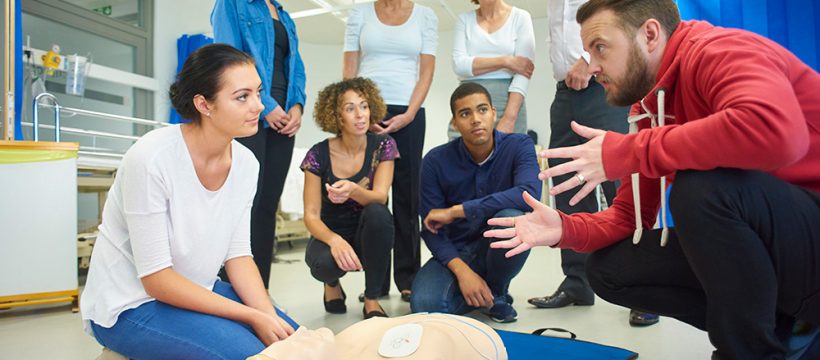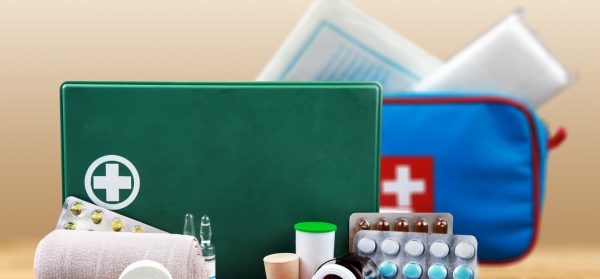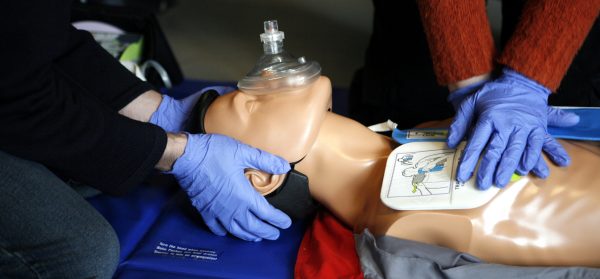
CPRNM® is a comprehensive directory designed to connect individuals and employers with top-tier training
providers including the AHA®, Red Cross®, and other training providers.*
Performing cardiopulmonary resuscitation can be as easy as its more commonly used acronym, CPR. Once training in CPR is complete it can seem like second nature to carry out if and when it is needed. Over time though, it helps to brush up on the methods and techniques. Let this ultimate cheat sheet on CPR be your guide to keeping up with this life saving skill.
Terms
CPR is a well-known acronym that fittingly comprises more helpful acronyms within its methods. Some popular ones include CCC (check, call, care), ACT (assess, call, treat), ABC (airway, breathing, compressions), CAB (compressions, airway, breathing), and AED (automated external defibrillator). In the event these sound a little unfamiliar, below is an ultimate cheat sheet on CPR terms to help clarify the alphabet soup of CPR.
1 second—length of time to give rescue breath
2—number of rescue breaths between compression cycles
30—compression count between rescue breaths
100-120—rate or speed of compressions per minute
911—emergency service number to call right away when determining medical response is necessary
Adult—grown person over 18 years
AED—automated external defibrillator, electric medical device used to detect arrhythmic heart rates and administer shock if needed
Airway—open using the head tilt/chin lift method to deliver rescue breaths
ACT—assess the situation, call 911, treat the victim by beginning CPR
BPM—beats per minute in a song that can help keep track of the 100-120 compressions needed per minute, examples: Staying Alive, Walk The Line, Crazy in Love etc
Call—for help, for and AED and 911 to receive emergency services
Cardiac arrest—heart ceases to function
Care—begin providing care to the victim such as CPR or first aid
Center of chest—between the nipples along breast bone
Check—view the scene for safety hazards
Chest rise—successful rescue breaths should inflate the chest slightly
Child—1-8 years old
Circulation—CPR circulates oxygenated blood through the body when the body is not doing so
Compressions—thrusts 1 ½ to 2 inches in depth into the center of the chest to promote oxygenated blood flow to vital organs
CPR—cardiopulmonary resuscitation
Hands-only CPR—CPR with compressions only and omitting rescue breaths, usually used by those untrained
Head tilt/Chin lift—maneuver to open the airway and deliver rescue breaths
Inches—1 ½ inch compression depth for infants, 2 inches compression depth for children through adults
Infant—up to one year old
Mask—CPR mask can be used to provide a barrier for delivering rescue breaths
Medical assistance—emergency services arriving as a result of calling 911
Mouth to mouth—method for delivering ventilation via rescue breaths from the rescuer’s mouth to the victim’s
Pulse—pattern of blood pumping through the body
Recovery position—left arm raised, rolled onto left side
Rescue breaths—given commonly from mouth-to-mouth method to breathe for the victim and deliver oxygen to lungs during CPR
Rocking motion—used to propel rescuer’s body into the victim’s for best compression delivery
Solid surface—victim should be moved to a solid surface (floor) if able to be done safely, for optimum positioning and support for CPR
Stack hands—both hands interlaced on top of each other in the center of the chest with heel of hand as base to deliver compressions
Teen—8-18 years of age
Emergency Response Scenario
With CPR terms above refreshed, it can help to visualize a CPR scenario to imprint these life saving steps. The more familiar with the procedure, the more likely to be used swiftly when needed.
When a person is found to suddenly collapse or be unresponsive, ACT:
- Assess the scene and the victim
- Is it free of surrounding hazards
- Is the victim responsive
- Tap them and ask “Are you ok” or “Can you hear me”
- Inform then you are here to help
- Is the victim breathing
- Is the victim on a hard flat surface
- Call for help
- Call 911
- Send someone to call 911 or call yourself, stay with the victim if possible
- Send someone to retrieve an AED if available
- Remain on the phone and follow 911 operator’s instructions
- Call 911
- Treat
- Begin CPR if victim is unresponsive and not breathing
CPR Run Through For Teens/Adults 8 Years and Up
Now that the ACT steps have a base line, time to refresh those CPR steps. Keep in mind the compression only option is available for teens through adults if the rescuer is untrained, out of practice, or uncertain.
- Give 30 Compressions
- Place heel of your hand in center of chest
- Interlock fingers of other hand on top
- Use your body weight to rock and push into chest
- Push hard and fast
- 2 inch depth
- 2 per second to reach 120 BPM
- Allow chest to return before compressing each time
- Give 2 Rescue Breaths (option for compressions only if untrained/uncertain)
- Head tilt/chin lift
- One had on top of forehead
- Other hand under chin
- Head tilt/chin lift
- Push forehead back
- Lift chin
- Pinch nose shut
- Cover mouth completely with yours to seal
- Breathe for 1 second
- Watch for victim’s chest to rise
- If it does, continue to 2 breaths total
- If it does not, conduct head tilt/chin lift again
- Return to compressions
- Continue Compression/Breath Cycle
- Trading out with another rescuer every couple minutes
- Until medical help arrives
- You are too exhausted to continue
CPR Run Through For Children 1-8 Years
CPR has some slight differences for younger victims. The combination of compressions and breaths is required for thorough CPR on child victims.
- Give 30 Compressions
- Place heel of your hand in center of chest
- Interlock fingers of other hand on top (one handed option for children)
- Use your body weight to rock and push into chest
- Push hard and fast
- 2 inch depth
- Nearly 2 per second, minimum 100 per minute
- Allow chest to return before compressing each time
- Give 2 Rescue Breaths
- Head tilt/chin lift
- One had on top of forehead
- Other hand under chin
- Head tilt/chin lift
- Push forehead back
- Lift chin
- Cover nose/mouth completely with yours to seal
- Option to pinch nose closed
- Breathe for 1 second
- Watch for victim’s chest to rise
- If it does, continue to 2 breaths total
- If it does not, conduct head tilt/chin lift and try again
- Return to compressions
- Continue Compression/Breath Cycle
- Trading out with another rescuer every couple minutes
- Until medical help arrives
- You are too exhausted to continue
CPR Run Through For Infants Up to 1 Year
CPR has some additional differences for the youngest of victims. The combination of compressions and breaths is vital for this age group as well, along with smaller compression depth and use of fingers for compressions due to their size.
- Give 30 Compressions
- Place 2-3 fingers in center of chest
- Use your body weight to rock and push into chest
- Push hard and fast
- 1 ½ inch depth
- Nearly 2 per second, minimum 100 per minute
- Allow chest to return before compressing each time
- Give 2 Rescue Breaths
- Head tilt/chin lift
- One had on top of forehead
- Other hand under chin
- Head tilt/chin lift
- Push forehead back
- Lift chin
- Cover nose/mouth completely with yours to seal
- Breathe for 1 second
- Watch for victim’s chest to rise
- Infant lungs are smaller so less force is needed to fill them
- If it does, continue to 2 breaths total
- Watch for victim’s chest to rise
- If it does not, conduct head tilt/chin lift and try again
- Return to compressions
- Continue Compression/Breath Cycle
- Trading out with another rescuer every couple minutes
- Until medical help arrives
- You are too exhausted to continue
This ultimate cheat sheet on CPR is a great tool for CPR emergency readiness. Recurrent training in CPR is strongly suggested to keep terms and skills sharp and up to date.
Can I use this info to become CPR certified?
We offer free online CPR classes and you only pay if you would like to purchase the certificate after you pass the test:
CPR /AED
CPR Certification Course
CPR (Adult, Pediatrics), AED
Workplace, Community
First-Aid
First-Aid Certification Course
Precautions & Injury Prevention
Workplace, Community
CPR / AED / First-Aid
CPR & First-Aid Certification
CPR (Adult, Pediatrics), First-Aid, AED
Workplace, Community
Bloodborne Pathogens
Bloodborne Pathogens Certification Course
Best Practices, Infection Control
Healthcare, Workplace, Community
Healthcare – CPR / AED
Healthcare CPR Certification Course
CPR (Adult, Pediatrics), Choking, AED
Healthcare, Workplace
Basic Life Support (BLS)
Basic Life Support Certification Course
CPR (Adult, Pediatrics), Choking, AED
BBP, First-Aid (Healthcare, Workplace)
 July 15, 2019
July 15, 2019 






